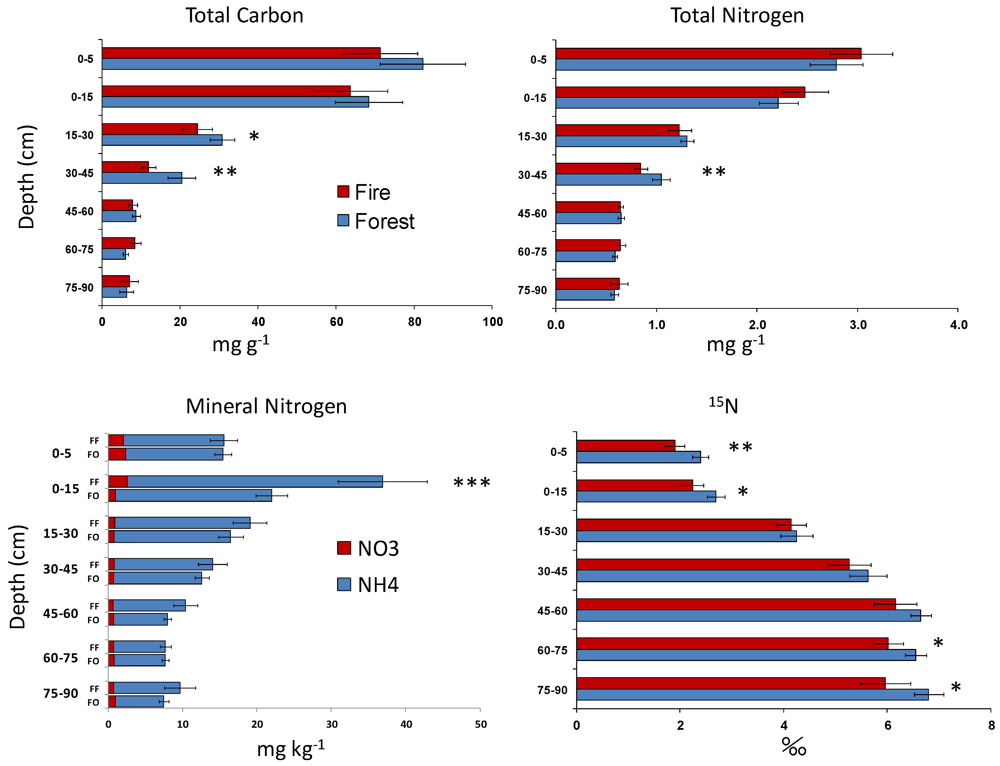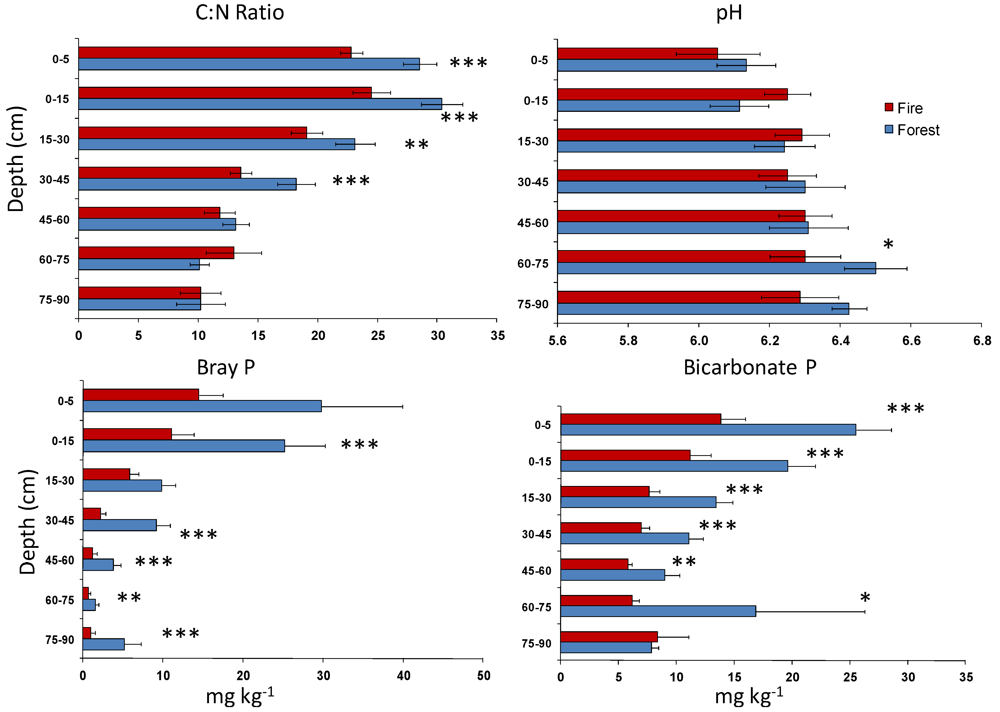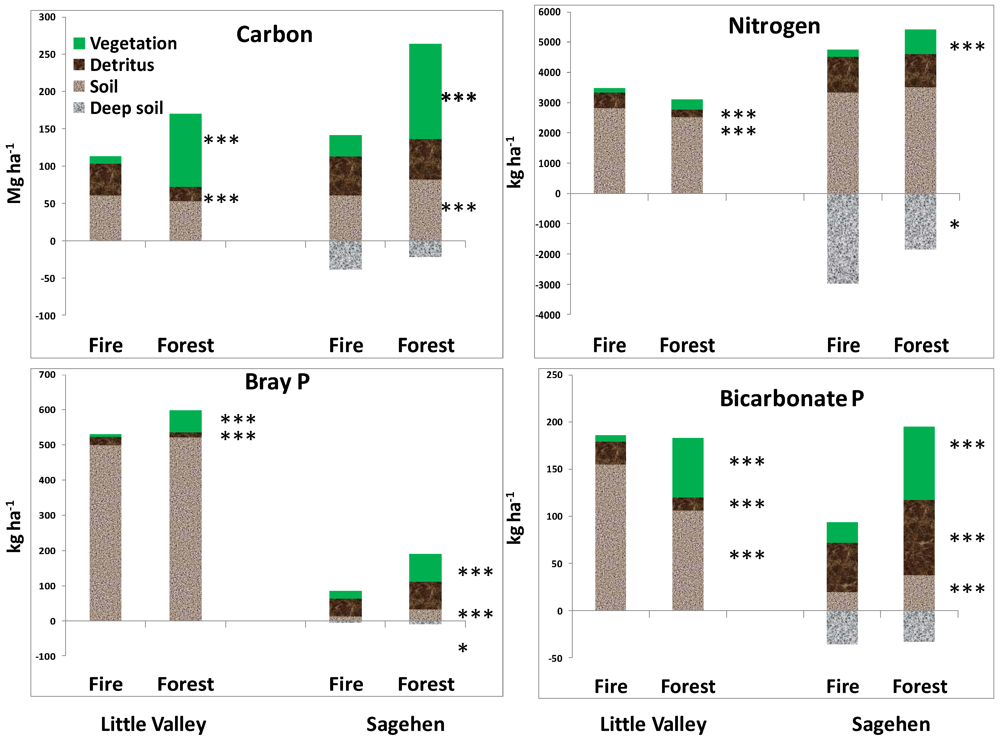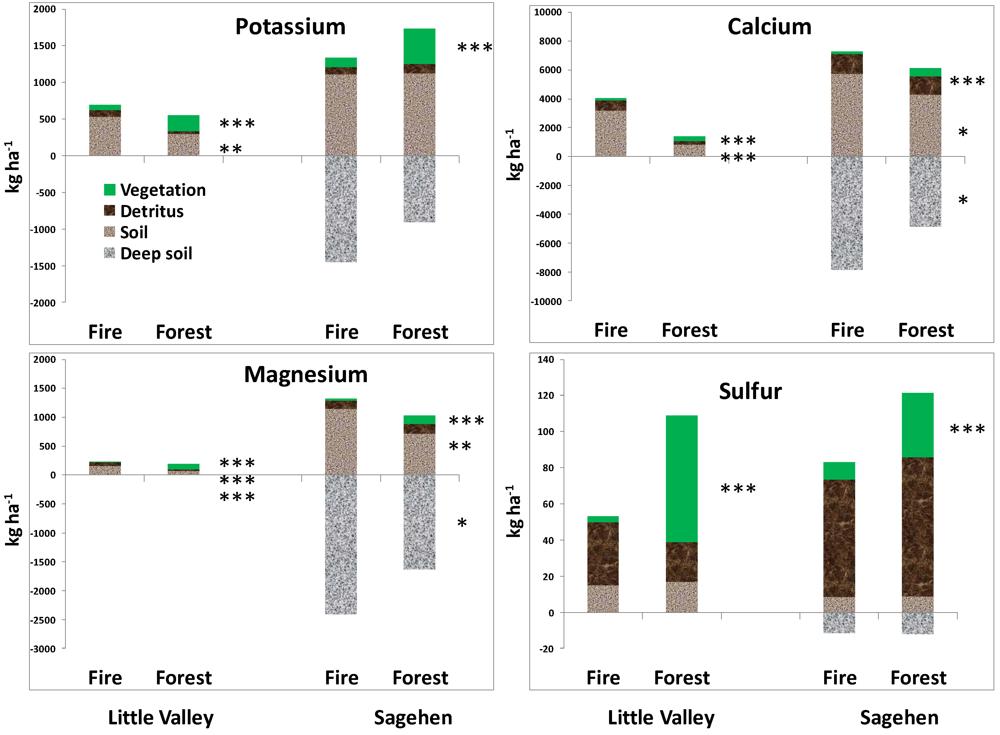The Long-Term Effects of Wildfire and Post-Fire Vegetation on Sierra Nevada Forest Soils
Abstract
:1. Introduction
2. Experimental Section
2.1. Sites
2.1.1. Sagehen
2.1.2. Little Valley
2.2. Methods
2.2.1. Sagehen
2.2.2. Little Valley
2.2.3. Statistical Analyses
3. Results and Discussion
3.1. Sagehen Site Results
3.1.1. Soil Physical and Chemical Properties
| Depth | Fire | Forest | Fire | Forest |
|---|---|---|---|---|
| (cm) | Bulk Density (g cm−2) | % > 2 mm | ||
| 0–15 | 0.89 ± 0.08 | 0.78 ± 0.09 | 49 ± 6 | 50 ± 4 |
| 15–30 | 1.33 ± 0.08 | 1.51 ± 0.11 | 54 ± 4 | 63 ± 4 * |
| 30–45 | 1.67 ± 0.13 | 1.57 ± 0.10 | 37 ± 5 | 53 ± 6 ** |
| 45–60 | 1.50 ± 0.09 | 1.56 ± 0.12 | 32 ± 6 | 42 ± 6 |
| 60–75 | 1.79 ± 0.32 | 1.46 ± 0.13 | 36 ± 5 | 42 ± 6 |
| 75–90 | 1.61 ± 0.21 | 1.25 ± 0.17 | 32 ± 2 | 43 ± 6 |
| Site | Depth | Site × Depth | |
|---|---|---|---|
| Degrees of Freedom | 1 | 6 | 5 |
| Bulk Density | 0.22 | <0.01 | 0.56 |
| %>2mm | 0.38 | 0.4 | 0.83 |
| pH | 0.43 | 0.02 | 0.63 |
| Total C | 0.12 | <0.01 | 0.6 |
| Total N | 0.96 | <0.01 | 0.50 |
| C:N Ratio | <0.01 | <0.01 | 0.17 |
| 15N | <0.01 | <0.01 | 0.62 |
| NH4+ | 0.04 | <0.01 | 0.53 |
| NO3− | 0.42 | <0.01 | 0.28 |
| Mineral N | 0.04 | <0.01 | 0.35 |
| Bray P | <0.01 | <0.01 | 0.15 |
| Bicarbonate P | <0.01 | <0.01 | 0.73 |
| K+ | 0.17 | <0.01 | 0.63 |
| Ca2+ | 0.03 | 0.78 | 0.12 |
| Mg2+ | 0.02 | <0.01 | 0.2 |
| SO42− | <0.01 | 0.31 | 0.05 |



3.1.2. O horizon and Mineral Soil Contents
| O Horizon | Soil (to 90 cm) | Total | |||||
|---|---|---|---|---|---|---|---|
| Former Fire | Forest | Former Fire | Forest | Former Fire | Forest | ||
| Mg ha−1 or kg ha−1 | |||||||
| Total C | 45.6 ± 2.2 | 49.1 ± 5.2 | 99.6 ± 10.4 | 103.5 ± 7.4 | 145.2 ± 8.3 | 152.6 ± 4.3 | |
| Total N | 1,186 ± 33 | 1,100 ± 70 | 6,321 ± 385 | 5,366 ± 415 * | 7,507 ± 380 | 6,466 ± 357 * | |
| NH4+–N | 92 ± 10 | 59 ± 5 | |||||
| NO3−–N | 7 ± 1 | 5 ± 0.3 | |||||
| Mineral N | 99 ± 12 | 64 ± 5 | |||||
| Bray P | 52 ± 7 | 79 ± 6 ** | 17 ± 1 | 43 ± 9 ** | 69 ± 8 | 123 ± 11 ** | |
| Bicarb P | 52 ± 7 | 79 ± 6 ** | 56 ± 8 | 71 ± 12 | 109 ± 15 | 150 ± 6 * | |
| K+ | 104 ± 27 | 129 ± 14 | 2,558 ± 306 | 2,036 ± 194 | 2,662 ± 332 | 2,165 ± 201 | |
| Ca2+ | 1,392 ± 111 | 1,261 ± 316 | 13,567 ± 1736 | 9,135 ± 1555 * | 14,959 ± 1795 | 10,396 ± 1330 * | |
| Mg2+ | 135 ± 5 | 162 ± 19 | 3,554 ± 675 | 2,348 ± 253 * | 3,689 ± 670 | 2,510 ± 246 * | |
| SO42−–S | 65 ± 10 | 77 ± 4 | 20 ± 1 | 21 ± 3 | 85 ± 10 | 98 ± 6 | |
3.1.3. Soil Solution and Leaching
| Former fire | Forest | P | |
|---|---|---|---|
| mg L−1 | |||
| NO3−–N | 0.74 ± 0.32 | 0.35 ± 0.11 | 0.22 |
| NH4+–N | 0.28 ± 0.09 | 0.39 ± 0.15 | 0.27 |
| Mineral N | 1.02 ± 0.36 | 0.54 ± 0.11 | 0.18 |
| Ortho-P | 0.03 ± 0.003 | 0.13 ± 0.09 | 0.02 |
| SO42−–S | 2.23 ± 0.13 | 2.19 ± 0.20 | 0.41 |
| Former Fire | Forest | P | |
|---|---|---|---|
| kg ha−1 | |||
| NO3−–N | 0.27 ± 0.10 | 0.35 ± 0.28 | 0.34 |
| NH4+–N | 0.14 ± 0.04 | 0.18 ± 0.11 | 0.33 |
| Mineral N | 0.41 ± 0.12 | 0.53 ± 0.38 | 0.33 |
| Ortho-P | 0.86 ± 0.04 | 0.90 ± 0.13 | 0.35 |
3.2. Comparisons to the Little Valley Study


3.3. Potential Reasons for the Differences between Sites
4. Conclusions
- (1) Soil total C and total N between former fire and forested sites are similar at both sites.
- (2) Ecosystem C is much lower in the former fire because of lower vegetation biomass and will not recover to pre-fire values until forest vegetation is re-established.
- (3) Ecosystem N lost during the fire has been more than made up for by post-fire N fixation at Little Valley and this is probably the case at Sagehen as well.
- (4) Soil exchangeable Ca2+, Mg2+, and to some degree K+ are greater in the former fire than in the forested sites, probably due largely to recycling by post-fire vegetation because potential ash inputs cannot account for the observed differences.
- (5) Mineral N leaching in the former fire is not greater than in the forested site despite the presence of N-fixers in the former.
- (6) The long-term effects of fire on soil and ecosystem P contents at the Sagehen site differ considerably: O horizon total P and soil extractable P were lower in the former fire at Sagehen whereas soil extractable P is either no different or higher in the former fire in Little Valley. This difference in P response at the two sites may be related to the inherently lower soil extractable P values at the Sagehen site overall, which in turn is a reflection of the andic nature of the soils there: one of the defining features of an andic soil is high sesquioxide content and high phosphate retention as a result [31].
Acknowledgments
Conflict of Interest
References
- Taylor, A.H. Identifying forest reference conditions on early cut-over lands, Lake Tahoe Basin, USA. Ecol. Appl. 2004, 14, 1903–1920. [Google Scholar] [CrossRef]
- Westerling, A.L.; Hidalgo, H.L.; Cayan, D.R.; Swetnam, W. Warming and earlier spring increases western U.S. forest wildfire activity. Science 2006, 313, 940–943. [Google Scholar] [CrossRef]
- Neary, D.G.; Klopatek, C.C.; DeBano, L.F.; Ffolliott, P.F. Fire effects on belowground sustainability: A review and synthesis. For. Ecol. Manag. 1999, 122, 51–71. [Google Scholar] [CrossRef]
- Certini, G. Effects of fire on properties of forest soils. Oecologia 2005, 143, 1–10. [Google Scholar] [CrossRef]
- Lynham, T.J.; Wickware, G.M.; Mason, J.A. Soil chemical changes and plant succession following experimental burning in immature jack pine. Can. J. Soil Sci. 1998, 78, 93–104. [Google Scholar]
- Hauer, F.R.; Spencer, C.N. Phosphorus and nitrogen dynamics in streams associated with wildfire: A study of immediate and longterm effects. Int. J. Wildland Fire 1998, 8, 183–198. [Google Scholar] [CrossRef]
- Carriera, J.A.; Arvevalo, J.R.; Neill, F.X. Soil degradation and nutrient availability in fire-prone Mediterranean shrublands of southeastern Spain. Arid Soil Res. Rehab. 1996, 10, 53–64. [Google Scholar] [CrossRef]
- Baird, M.; Zabowski, D.; Everett, R.L. Wildfire effects on carbon and nitrogen in inland coniferous forests. Plant Soil 1999, 209, 233–243. [Google Scholar] [CrossRef]
- Caldwell, T.G.; Johnson, D.W.; Miller, W.W.; Qualls, R.G. Forest floor carbon and nitrogen losses due to prescription fire. Soil Sci. Soc. Am. J. 2002, 66, 262–267. [Google Scholar]
- Grier, C.L. Wildfire effects on nutrient distribution and leaching in a coniferous ecosystem. Can. J. For. Res. 1975, 5, 599–607. [Google Scholar] [CrossRef]
- Johnson, D.W.; Susfalk, R.B.; Caldwell, T.G.; Murphy, J.D.; Miller, W.W.; Walker, F.F. Fire effects on carbon and nitrogen budgets in forests. Water Air Soil Pollut. Focus 2004, 4, 263–275. [Google Scholar]
- Johnson, D.W.; Murphy, J.D.; Walker, R.F.; Miller, W.W.; Todd, D.E. The combined effects of thinning and prescribed fire on carbon and nutrient budgets in a Jeffrey Pine Forests. Ann. For. Sci. 2008, 65, 601–612. [Google Scholar] [CrossRef]
- Rasion, R.J.; Khanna, P.K.; Woods, P.V. Mechanisms of element transfer to the atmosphere during vegetation fires. Can. J. For. Res. 1985, 15, 132–140. [Google Scholar] [CrossRef]
- Trabaud, L. The effect of fire on nutrient losses and cycling in a Quercus coccifera garrigue (southern France). Oecologia 1994, 99, 379–386. [Google Scholar] [CrossRef]
- Auclair, A.N. Postfire regeneration of plant and soil organic pools in a Picea mariana-Cladonia stellaris ecosystem. Can. J. For. Res. 1985, 15, 297–291. [Google Scholar]
- Binkley, D.; Cromack, K.; Fredriksen, R.L. Nitrogen accretion and availability in some snowbrush ecosystems. For. Sci. 1982, 28, 720–724. [Google Scholar]
- Johnson, D.W.; Murphy, J.F.; Susfalk, R.B.; Caldwell, T.G.; Miller, W.W.; Walker, R.B.; Powers, R.F. The effects of wildfire, salvage logging and post-fire N-fixation on the nutrient budgets of a Sierran Forest. For. Ecol. Manag. 2005, 220, 155–165. [Google Scholar] [CrossRef]
- Johnson, C.M.; Needham, P.R. Ionic composition of Sagehen Creek, California following an adjacent fire. Ecology 1966, 47, 636–639. [Google Scholar] [CrossRef]
- Youngberg, C.T.; Wollum, A.G. Nitrogen accretion in developing Ceanothus velutinus stands. Soil Sci. Soc. Am. J. 1976, 40, 109–112. [Google Scholar] [CrossRef]
- Zavitovski, J.; Newton, M. Ecological importance of snowbrush Ceanothus velutinus in the Oregon Cascades. Ecology 1968, 49, 1113–1145. [Google Scholar] [CrossRef]
- Johnson, D.W.; Susfalk, R.B.; Dahlgren, R.A. Nutrient fluxes in forests of the eastern Sierra Nevada Mountains. Glob. Biogeochem. Cyc. 1997, 11, 673–681. [Google Scholar] [CrossRef]
- Rau, B.M.; Melvin, A.M.; Johnson, D.W.; Goodale, C.L.; Blank, R.R.; Fredicksen, G.; Todd, D.E., Jr.; Miller, W.W.; Murphy, J.D.; Walker, R.F. Revisiting soil C and N sampling: Quantitative pits vs. rotary cores. Soil Sci. 2011, 176, 273–279. [Google Scholar]
- Gholz, H.; Grier, C.C.; Campbell, A.; Brown, A. Equations for Estimating Biomass and Leaf Area of Plants in the Pacific Northwest; Research Paper 41; Forest Research Laboratory, Oregon State University: Corvallis, OR, USA, 1979. [Google Scholar]
- Pyne, S.J.; Andrews, P.L.; Laven, R.D. Introduction to Wildland Fire, 2nd ed; John Wiley and Sons: New York, NY, USA, 1996. [Google Scholar]
- Avery, T.E.; Burkhart, T.E. Forest Measurements, 5th ed; McGraw-Hill: New York, NY, USA, 2002. [Google Scholar]
- Hurlbert, S.H. Pseudoreplication and the design of ecological field experiments. Ecol. Mon. 1984, 54, 187–211. [Google Scholar] [CrossRef]
- Murphy, J.D.; Johnson, D.W.; Miller, W.W.; Walker, R.F.; Carroll, E.M.; Blank, R.R. Wildfire effects on soil nutrients and leaching in a Tahoe Basin watershed. J. Environ. Qual. 2006, 35, 479–489. [Google Scholar] [CrossRef]
- Oskanen, L. Logic of experiments in ecology: Is pseudoreplication a pseudoissue? Oikos 2001, 94, 27–38. [Google Scholar]
- Stein, C.M. Post-fire Vegetation in Sierran Forests: Effects of Nitrogen Fixation, Soil Nitrogen Availability, and Water Quality. M.S. Thesis, Hydrologic Sciences, University of Nevada, Reno, NV, USA, 2006. [Google Scholar]
- Stein, C.M.; Johnson, D.W.; Miller, W.W.; Powers, R.F.; Young, D.A.; Glass, D.W. Snowbrush (Ceanothus velutinus Dougl.) effects on soil leaching and water quality in a Sierran ecosystem. Ecohydrology 2010, 3, 79–97. [Google Scholar]
- Buol, S.W.; Hole, F.D.; McCracken, R.J.; Southard, R.J. Soil Genesis and Classification, 4th ed; Iowa State University Press: Ames, IA, USA, 1997; p. 65. [Google Scholar]
© 2012 by the authors; licensee MDPI, Basel, Switzerland. This article is an open-access article distributed under the terms and conditions of the Creative Commons Attribution license (http://creativecommons.org/licenses/by/3.0/).
Share and Cite
Johnson, D.W.; Walker, R.F.; McNulty, M.; Rau, B.M.; Miller, W.W. The Long-Term Effects of Wildfire and Post-Fire Vegetation on Sierra Nevada Forest Soils. Forests 2012, 3, 398-416. https://doi.org/10.3390/f3020398
Johnson DW, Walker RF, McNulty M, Rau BM, Miller WW. The Long-Term Effects of Wildfire and Post-Fire Vegetation on Sierra Nevada Forest Soils. Forests. 2012; 3(2):398-416. https://doi.org/10.3390/f3020398
Chicago/Turabian StyleJohnson, Dale W., Roger F. Walker, Michelle McNulty, Benjamin M. Rau, and Watkins W. Miller. 2012. "The Long-Term Effects of Wildfire and Post-Fire Vegetation on Sierra Nevada Forest Soils" Forests 3, no. 2: 398-416. https://doi.org/10.3390/f3020398




